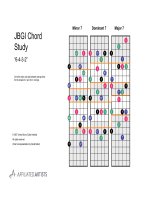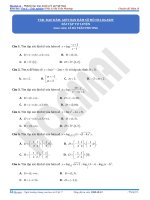03 2 block annotated tủ tài liệu bách khoa
Bạn đang xem bản rút gọn của tài liệu. Xem và tải ngay bản đầy đủ của tài liệu tại đây (1.06 MB, 16 trang )
Online
Cryptography
Course
Dan
Boneh
Block
ciphers
The
data
encryp4on
standard
(DES)
Dan
Boneh
Block
ciphers:
crypto
work
horse
n bits
PT Block
n bits
CT Block
E, D
Key
k Bits
Canonical examples:
1. 3DES: n= 64 bits,
2. AES:
k = 168 bits
n=128 bits, k = 128, 192, 256 bits
Dan
Boneh
Block
Ciphers
Built
by
Itera4on
key
k
k2
k3
kn
R(k2,
⋅)
R(k3,
⋅)
R(kn,
⋅)
m
k1
R(k1,
⋅)
key
expansion
c
R(k,m)
is
called
a
round
func4on
for
3DES
(n=48),
for
AES-‐128
(n=10)
Dan
Boneh
The
Data
Encryp4on
Standard
(DES)
• Early
1970s:
Horst
Feistel
designs
Lucifer
at
IBM
key-‐len
=
128
bits
;
block-‐len
=
128
bits
• 1973:
NBS
asks
for
block
cipher
proposals.
IBM
submits
variant
of
Lucifer.
• 1976:
NBS
adopts
DES
as
a
federal
standard
key-‐len
=
56
bits
;
block-‐len
=
64
bits
• 1997:
DES
broken
by
exhaus4ve
search
• 2000:
NIST
adopts
Rijndael
as
AES
to
replace
DES
Widely
deployed
in
banking
(ACH)
and
commerce
Dan
Boneh
DES:
core
idea
–
Feistel
Network
Given
func4ons
f1,
…,
fd:
{0,1}n
⟶
{0,1}n
Goal:
build
inver4ble
func4on
F:
{0,1}2n
⟶
{0,1}2n
L1
f2
⊕
⊕
L0
f1
R1
input
R2
L2
⋯
Rd-‐1
Ld-‐1
fd
⊕
n-‐bits
n-‐bits
R0
Rd
Ld
output
In
symbols:
Dan
Boneh
L1
f2
⊕
⊕
L0
f1
R1
R2
L2
⋯
Rd-‐1
Ld-‐1
Rd
fd
Ld
⊕
n-‐bits
n-‐bits
R0
input
output
Claim:
for
all
f1,
…,
fd:
{0,1}n
⟶
{0,1}n
Feistel
network
F:
{0,1}2n
⟶
{0,1}2n
is
inver4ble
Proof:
construct
inverse
Li-‐1
fi
⊕
Ri-‐1
Ri
Li
inverse
Ri-‐1
=
Li
Li-‐1
=
fi(Li)
⨁
Ri
Dan
Boneh
L1
f2
⊕
⊕
L0
f1
R1
R2
L2
⋯
Rd-‐1
Ld-‐1
Rd
fd
Ld
⊕
n-‐bits
n-‐bits
R0
input
output
Claim:
for
all
f1,
…,
fd:
{0,1}n
⟶
{0,1}n
Feistel
network
F:
{0,1}2n
⟶
{0,1}2n
is
inver4ble
Proof:
construct
inverse
Li-‐1
fi
⊕
Ri-‐1
Ri
Li
inverse
Ri
Li
⊕
fi
Ri-‐1
Li-‐1
Dan
Boneh
Decryp4on
circuit
n-‐bits
n-‐bits
Rd
Ld
⊕
fd
Rd-‐1
Ld-‐1
⊕
fd-‐1
Rd-‐2
Ld-‐2
⋯
R1
L1
⊕
f1
R0
L0
• Inversion
is
basically
the
same
circuit,
with
f1,
…,
fd
applied
in
reverse
order
• General
method
for
building
inver4ble
func4ons
(block
ciphers)
from
arbitrary
func4ons.
• Used
in
many
block
ciphers
…
but
not
AES
Dan
Boneh
“Thm:”
(Luby-‐Rackoff
‘85):
f:
K
×
{0,1}n
⟶
{0,1}n
a
secure
PRF
⇒
3-‐round
Feistel
F:
K3
×
{0,1}2n
⟶
{0,1}2n
a
secure
PRP
⊕
input
L1
f
⊕
L0
f
R1
R2
L2
f
⊕
R0
R3
L3
output
Dan
Boneh
DES:
16
round
Feistel
network
f1,
…,
f16:
{0,1}32
⟶
{0,1}32
,
fi(x)
=
F(
ki,
x
)
k
key
expansion
input
IP
k2
⋯
k16
16
round
Feistel
network
To
invert,
use
keys
in
reverse
order
IP-‐1
64
bits
64
bits
k1
output
Dan
Boneh
The
func4on
F(ki,
x)
S-‐box:
func4on
{0,1}6
⟶
{0,1}4
,
implemented
as
look-‐up
table.
Dan
Boneh
The
S-‐boxes
Si:
{0,1}6
⟶
{0,1}4
Dan
Boneh
Example:
a
bad
S-‐box
choice
Suppose:
Si(x1,
x2,
…,
x6)
=
(
x2⨁x3,
x1⨁x4⨁x5,
x1⨁x6,
x2⨁x3⨁x6
)
or
wrijen
equivalently:
Si(x)
=
Ai⋅x
(mod
2)
We
say
that
Si
is
a
linear
func4on.
0
1
1
0
0
0
1
0
0
1
1
0
1
0
0
0
0
1
0
1
1
0
0
1
x1
.
x2
x3
x4
x5
x6
=
x2⨁x3
x1⨁x4⨁x5
x1⨁x6
x2⨁x3⨁x6
Dan
Boneh
Example:
a
bad
S-‐box
choice
Then
en4re
DES
cipher
would
be
linear:
∃fixed
binary
matrix
B
s.t.
832
DES(k,m)
=
64
m
.
k1
k2
B
=
c
(mod
2)
⋮
k
16
But
then:
DES(k,m1)
⨁
DES(k,m2)
⨁
DES(k,m3)
=
DES(k,
m1⨁m2⨁m3)
B
m
k
1
⨁
B
m
2
⨁
B
m
3
=
B
m
1⨁m2⨁m3
k
k
k⨁k⨁k
Dan
Boneh
Choosing
the
S-‐boxes
and
P-‐box
Choosing
the
S-‐boxes
and
P-‐box
at
random
would
result
in
an
insecure
block
cipher
(key
recovery
amer
≈224
outputs)
[BS’89]
Several
rules
used
in
choice
of
S
and
P
boxes:
• No
output
bit
should
be
close
to
a
linear
func.
of
the
input
bits
• S-‐boxes
are
4-‐to-‐1
maps
⋮
Dan
Boneh
End
of
Segment
Dan
Boneh









